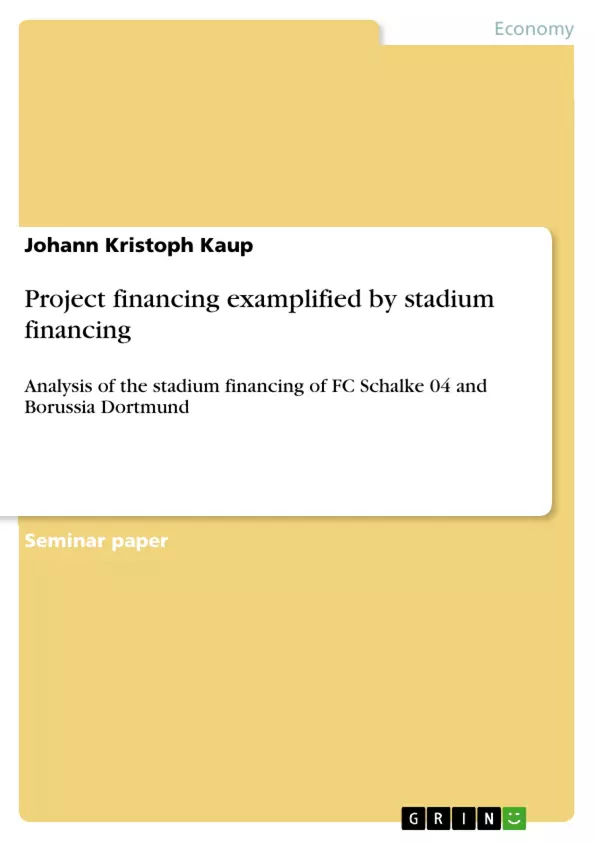Clubs need financial concepts to realise player´s transfers as well as the improvement of facilities like the club´s stadium. The second will be explored with this term paper. Foremost project financing is used in terms of stadium financing and other major infrastructural projects. But what do the participants have to consider in financing major projects? In doing so, what is important to accomplish the fulfilment of the project and what issues can arise?
To answer these questions this work should give an insight into financing major projects exemplified by the stadium financing of FC Schalke 04 and Borussia Dortmund. In the course of this the main characteristics of project financing will be presented in detail. Also risks are displayed. The findings should lead to a recommendation of project financing for stadium financing.
Within the professionalization of the football business in Germany clubs face more severe licensing standards defined by the Deutsche Fußball Liga (DFL). This includes infrastructural adjustments of stadiums as well as training grounds. Especially hosting the World Cup in 2006 introduced a modernisation of stadiums in Germany through the DFL and challenged clubs in terms of stadium financing. In Brazil the World Cup in 2014 and the recently finished Olympics in 2016 caused infrastructural adjustments in the hosting cities as well.
Inhaltsverzeichnis (Table of Contents)
- Introduction
- Problem definition and objective
- Course of investigation
- Theoretical background
- Distinction between general corporate financing and project financing
- Definition and application of project financing
- Participants
- Forms of financing
- Risk management
- Case studies of project financing
- Arena Auf Schalke
- Westfalenstadion
- Critical discussion and recommendation
- Conclusion and outlook
Zielsetzung und Themenschwerpunkte (Objectives and Key Themes)
This term paper explores the use of project financing in the context of stadium financing for professional football clubs in Germany. The paper examines the financial challenges faced by clubs in meeting licensing requirements for stadiums and improving facilities. It then delves into the theoretical framework of project financing, including its definition, application, participants, forms, and risk management strategies.
- Project financing as a tool for stadium development
- The challenges of stadium financing in professional football
- Key principles and elements of project financing
- Risk management in project financing
- Case studies of successful stadium financing projects
Zusammenfassung der Kapitel (Chapter Summaries)
The introduction establishes the context for the paper by highlighting the increasing financial demands on professional football clubs in Germany, driven by factors such as licensing standards, the growth of the football business, and the need to maintain competitiveness. It outlines the challenges posed by stadium financing and the need for effective financial strategies.
The chapter on theoretical background delves into the concept of project financing, distinguishing it from general corporate financing. It defines project financing, explores its application in various sectors, and identifies the key participants involved. This section also examines the various forms of project financing and the essential aspects of risk management in this context.
The paper then moves on to present case studies of successful stadium financing projects, focusing on the Arena Auf Schalke and the Westfalenstadion. These case studies provide insights into the practical application of project financing in real-world scenarios, highlighting the specific challenges and opportunities associated with stadium development.
Schlüsselwörter (Keywords)
This term paper focuses on the key concepts of project financing, stadium financing, football business, licensing standards, financial challenges, risk management, and case studies.
- Arbeit zitieren
- Johann Kristoph Kaup (Autor:in), 2016, Project financing examplified by stadium financing, München, GRIN Verlag, https://www.grin.com/document/429833



